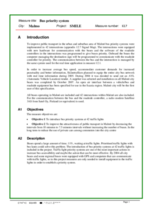Installing a bus priority system
Thematic areas
Smart, Sustainable, Connected and Shared mobility
Summary
Traffic light priority systems are one of the most effective ways of improving bus speed and punctuality.
Implementing sustainable mobility
Buses generally use the same road space as other traffic, and are therefore subject to delays and disruptions. In order to encourage more people to use public transportation, it is essential to improve service quality, cut journey times and ensure punctuality. Prior to the CIVITAS SMILE measure, buses spent some 11 percent of their journey time waiting at traffic lights. The aim was therefore to introduce bus priority systems at 42 sets of traffic lights, improving the bus service in Malmo by increasing frequency from 10 minutes to 7.5 minutes without having to introduce additional vehicles.
Progress
By 2004, all city buses and some regional buses had been equipped with GPS and computers that can communicate with the traffic light controls to request priority. This measure therefore involved only the installation of equipment in the traffic lights in order to establish the priority system, and the programming of the on-board computers. This was completed in 2008.
Outcomes
Journey times were reduced as a result of the system. Average bus speed during the day increased from 15.4 to 16.1 km/h towards the city centre, and from 15.9 to 16.5 km/h away from the city centre. The best results were recorded in the afternoon peak period, when average bus speeds rose nearly 10 percent, from 14.1 to 15.5 km/h. There was also an improvement in punctuality: from 23 to 25 percent towards the city centre, and from 25 to 29 percent away from the city centre.









